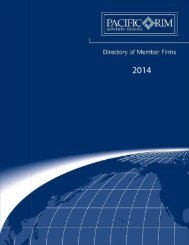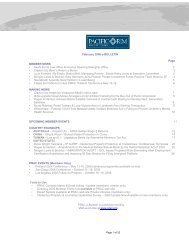A Guide to the Law of Securitisation in Australia - Clayton Utz
A Guide to the Law of Securitisation in Australia - Clayton Utz
A Guide to the Law of Securitisation in Australia - Clayton Utz
- No tags were found...
You also want an ePaper? Increase the reach of your titles
YUMPU automatically turns print PDFs into web optimized ePapers that Google loves.
– claims <strong>in</strong> respect <strong>of</strong> moneys advanced by a person <strong>to</strong> <strong>the</strong>company for <strong>the</strong> purposes set out <strong>in</strong> <strong>the</strong> previousparagraph; and– certa<strong>in</strong> audi<strong>to</strong>r’s fees.(c) claims secured by a float<strong>in</strong>g charge <strong>to</strong> <strong>the</strong> extent that <strong>the</strong>ymay be paid by realisation <strong>of</strong> <strong>the</strong> property subject <strong>to</strong> <strong>the</strong>float<strong>in</strong>g charge;(d) claims <strong>in</strong> respect <strong>of</strong> which <strong>the</strong> company has received<strong>in</strong>surance proceeds <strong>to</strong> <strong>the</strong> extent <strong>of</strong> those proceeds;(e) certa<strong>in</strong> costs <strong>in</strong> <strong>the</strong> w<strong>in</strong>d<strong>in</strong>g-up and adm<strong>in</strong>istration <strong>of</strong> <strong>the</strong>company;(f) certa<strong>in</strong> claims by employees or <strong>in</strong> respect <strong>of</strong> <strong>in</strong>jurycompensation which were not paid under items (b) and (d);and(g) claims <strong>of</strong> all credi<strong>to</strong>rs proportionally <strong>in</strong> relation <strong>to</strong> <strong>the</strong> amoun<strong>to</strong>f <strong>the</strong>ir claim.9.2.3 The role <strong>of</strong> an adm<strong>in</strong>istra<strong>to</strong>rThe provisions <strong>in</strong> <strong>the</strong> Corporations Act <strong>in</strong> relation <strong>to</strong> <strong>the</strong>appo<strong>in</strong>tment <strong>of</strong> adm<strong>in</strong>istra<strong>to</strong>rs <strong>to</strong> companies are also relevant <strong>in</strong>respect <strong>of</strong> <strong>the</strong> <strong>in</strong>solvency <strong>of</strong> a special purpose corporation. Theseprovisions allow an adm<strong>in</strong>istra<strong>to</strong>r <strong>to</strong> be appo<strong>in</strong>ted <strong>to</strong> a companyfor a period <strong>of</strong> 28 days (or 35 days over <strong>the</strong> Christmas or Easterperiods). The adm<strong>in</strong>istra<strong>to</strong>r takes control <strong>of</strong> <strong>the</strong> company’s affairsand <strong>in</strong>vestigates whe<strong>the</strong>r it is <strong>in</strong> <strong>the</strong> <strong>in</strong>terests <strong>of</strong> credi<strong>to</strong>rs <strong>of</strong> <strong>the</strong>company <strong>to</strong> enter <strong>in</strong><strong>to</strong> a deed <strong>of</strong> company arrangement <strong>to</strong>overcome <strong>the</strong> company’s f<strong>in</strong>ancial difficulties.An adm<strong>in</strong>istra<strong>to</strong>r may be appo<strong>in</strong>ted by <strong>the</strong> company, a liquida<strong>to</strong>ror a provisional liquida<strong>to</strong>r <strong>of</strong> <strong>the</strong> company or a chargee who isentitled <strong>to</strong> enforce a charge over <strong>the</strong> whole, or substantially <strong>the</strong>whole, <strong>of</strong> <strong>the</strong> company’s property.For present purposes <strong>the</strong> follow<strong>in</strong>g two aspects <strong>of</strong> adm<strong>in</strong>istrationare significant:• Dur<strong>in</strong>g <strong>the</strong> period <strong>of</strong> <strong>the</strong> adm<strong>in</strong>istration, a proceed<strong>in</strong>g <strong>in</strong> acourt aga<strong>in</strong>st <strong>the</strong> company or <strong>in</strong> relation <strong>to</strong> any <strong>of</strong> its propertycannot be begun or proceeded with, <strong>the</strong> owner or lessor <strong>of</strong>property that is used or occupied by or is <strong>in</strong> <strong>the</strong> possession <strong>of</strong><strong>the</strong> company cannot take possession <strong>of</strong> <strong>the</strong> property oro<strong>the</strong>rwise recover it, no enforcement process <strong>in</strong> relation <strong>to</strong><strong>the</strong> property <strong>of</strong> <strong>the</strong> company can be begun or proceeded withand a person cannot enforce a charge on <strong>the</strong> property <strong>of</strong> <strong>the</strong>company except, <strong>in</strong> each case, with <strong>the</strong> adm<strong>in</strong>istra<strong>to</strong>r’swritten consent or with <strong>the</strong> leave <strong>of</strong> a court.• Despite <strong>the</strong> rules <strong>in</strong> <strong>the</strong> previous paragraph, a chargee whichhas a charge over <strong>the</strong> whole, or substantially <strong>the</strong> whole, <strong>of</strong><strong>the</strong> property <strong>of</strong> <strong>the</strong> company may enforce <strong>the</strong> charge <strong>in</strong>relation <strong>to</strong> all property subject <strong>to</strong> <strong>the</strong> charge provided that itdoes so with<strong>in</strong> 10 bus<strong>in</strong>ess days <strong>of</strong> <strong>the</strong> date that <strong>the</strong> chargeereceives notice <strong>of</strong> <strong>the</strong> appo<strong>in</strong>tment <strong>of</strong> <strong>the</strong> adm<strong>in</strong>istra<strong>to</strong>r.9.3 Insolvent trusts and trusteesWhere an issuer <strong>in</strong> a securitisation program is <strong>the</strong> trustee <strong>of</strong> atrust, <strong>the</strong> <strong>in</strong>solvency <strong>of</strong> <strong>the</strong> trust and that <strong>of</strong> <strong>the</strong> trustee must bedist<strong>in</strong>guished.9.3.1 Insolvency <strong>of</strong> <strong>the</strong> trustStrictly speak<strong>in</strong>g a trust cannot be <strong>in</strong>solvent. This is becausetrusts do not have any legal capacity. A trust cannot sue or besued and nei<strong>the</strong>r can it have a liquida<strong>to</strong>r or adm<strong>in</strong>istra<strong>to</strong>rappo<strong>in</strong>ted <strong>to</strong> it.When a trust is said <strong>to</strong> <strong>in</strong>cur a liability (for <strong>in</strong>stance, when a bondis issued by a trustee <strong>in</strong> a securitisation program) <strong>the</strong> follow<strong>in</strong>g<strong>in</strong> fact occurs:• <strong>the</strong> trustee itself <strong>in</strong>curs <strong>the</strong> liability;• <strong>the</strong> trustee by virtue <strong>of</strong> <strong>in</strong>curr<strong>in</strong>g <strong>the</strong> liability, provided that itwas <strong>in</strong>curred for <strong>the</strong> purposes <strong>of</strong> <strong>the</strong> trust and <strong>in</strong> accordancewith <strong>the</strong> provisions <strong>of</strong> <strong>the</strong> relevant trust deed, will be entitled<strong>to</strong> be <strong>in</strong>demnified from <strong>the</strong> assets <strong>of</strong> <strong>the</strong> trust aga<strong>in</strong>st <strong>the</strong>liability and will have a lien over <strong>the</strong> assets <strong>of</strong> <strong>the</strong> trust <strong>to</strong>secure its rights under <strong>the</strong> <strong>in</strong>demnity; and• unless o<strong>the</strong>rwise agreed, <strong>the</strong> trustee must meet its liabilitieswith respect <strong>to</strong> <strong>the</strong> trust from its own assets if its <strong>in</strong>demnityfrom <strong>the</strong> assets <strong>of</strong> trust is <strong>in</strong>sufficient.In securitisation programs which have trustee issuers, <strong>the</strong>obligations <strong>of</strong> <strong>the</strong> trustee <strong>to</strong> <strong>in</strong>ves<strong>to</strong>rs and o<strong>the</strong>r credi<strong>to</strong>rs will<strong>in</strong>variably be limited <strong>to</strong> <strong>the</strong> assets <strong>of</strong> <strong>the</strong> trust out <strong>of</strong> which <strong>the</strong>trustee is <strong>in</strong>demnified for <strong>the</strong> liability (<strong>in</strong> <strong>the</strong> absence <strong>of</strong> fraud,negligence or wilful default on <strong>the</strong> part <strong>of</strong> <strong>the</strong> trustee). Howeverthis limitation does not affect <strong>the</strong> nature <strong>of</strong> <strong>the</strong> liability. Theliability is <strong>the</strong> trustee’s liability – albeit one which is limited byreference <strong>to</strong> <strong>the</strong> trustee’s <strong>in</strong>demnity from <strong>the</strong> assets <strong>of</strong> <strong>the</strong> trust.Thus, a reference <strong>to</strong> a trust be<strong>in</strong>g <strong>in</strong>solvent is really a shorthandway <strong>of</strong> say<strong>in</strong>g that <strong>the</strong> obligations which <strong>the</strong> trustee has properly<strong>in</strong>curred as trustee <strong>of</strong> <strong>the</strong> trust cannot be met from <strong>the</strong> proceeds<strong>of</strong> <strong>the</strong> trustee’s <strong>in</strong>demnity from <strong>the</strong> assets <strong>of</strong> <strong>the</strong> trust. Theconsequences <strong>of</strong> this <strong>in</strong>clude:53






